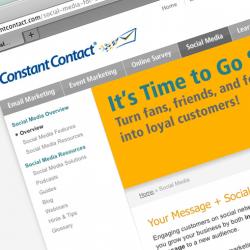
I won’t name any names, but I’ve recently been hearing a lot of ads proclaiming that if you add social media to your email marketing, then you’ll be able to supercharge your email marketing.
The premise is that if you add the social media icons to your email marketing, your subscribers will forward share the content via their social circles.
I have heard way too often marketers treat email and social media as a magic bullet for marketing online. Yes, I agree they are great traffic generation tools. I address each of these methods in my book (although I don’t specifically talk about tying them together because that would be too tactical for my tastes). However, I think that there is one key component that companies do, such as the company who shall remain nameless, to significantly mislead their audience... that is to say that if you market via email (or social media) then you'll never want for more business.
I don’t want to leave anyone out of this, so let me be clear. I don’t think that this misleading advertising only exists in email marketing companies. It’s been going on for years. It’s the radio, television and newspaper salesman that says, “You’ll get more business if you are on [insert media here].” It’s the yellow page rep that convinces businesses to pay thousands of dollars each year because of [insert your reason here].
The problem I have with the email marketers, especially when talking about how effective social media is, is that they never talk about how much work it is to really do it right.
Don’t get me wrong… I know they have tutorials, info guides and educational materials. In fact, they have so much information available on their websites that I am sure they understand this principle very well. They know how hard it is. They know there is far more to an email that putting some text in a random (pretty) template and hitting send. I just get frustrated when they make it sound so easy.
I think there are three key reasons why email marketing fails. I think that these also apply to social media.
List Management
List management is the most important of these three areas where email marketing fails. The most common approach to email marketing is that people take all the people in their database and start emailing them. They don’t look to whether they have opted in or whether or not the content is applicable.
I can always tell when someone is starting a new email marketing campaign because I’ll get subscribed a couple of times since I have a few emails that I use on a regular basis. It’s obvious they have just stripped their Outlook or GMail account and started emailing everyone. They put no thought into how to appropriate start and manage their list.
The other issue is they don’t actively manage their email lists. Different people are willing to take action differently than others. Because of this difference, we need to manage the subscribers differently. Customers react differently than prospects. Prospects react differently than people you just met at a convention or networking event. Because of this difference, we need to actively manage lists of people as groups that will act differently.
Above all, don’t buy email lists… don’t do it.
Content
Next to list management, this is probably the most important area of failure for email marketers. Too much text and a confusing message can cause the people to simply ignore your message… or worse, send your email message to their spam filter (which you never know).
Content relates to your text, obviously. But, it also refers to imagery and video. When you have images that support your message that are well thought out, people will be able to see what your point is quickly and increase likelihood of action.
Really, when it comes down to it, content needs to speak to your audience. If you have an audience that is looking for a lot of news, then a lot of text is appropriate. When you have an audience that is looking for the daily deal, then you need one, bold message/image that allows them to act quickly.
Know your audience and the content should then follow.
Frequency/Timing
Sometimes I get emails way too often. Sometimes I get emails not nearly as often as I’d like. The problem we have as email marketers is that we don’t really know what people expect.
When I sign up for a newsletter from a publisher of news, I’m probably expecting that I will receive something on a daily (or sometimes more often) basis. When I sign up for a blogger’s email distribution I’m probably going to expect emails multiple times per week. If I sign up for a newsletter from a business that I shop with (retail or commercial) then I probably don’t want to receive emails very often.
This can be a tricky thing to master. This is one of the key reasons why list management is so important. Different people will want to receive their emails at different frequencies and at different times. You have to test what works and what doesn’t work.
Bottom Line
Email marketing fails because marketers don’t really take the time to properly understand and manage their email marketing efforts. They send emails inconsistently, they try to get too much information in an email or they send emails to people that never really wanted the message in the first place.
In order to be effective in email marketing, you need to take the time to manage it effectively. Look at the analytics your email marketing provider has and always test new concepts to see what is the most effective.
Of course, it may just be better to hire it all out.
Either way, it’s going to take time to do it right. It’s not something that you can just throw together in a few minutes and expect it to be effective. It requires planning and consistent execution to be successful.
It would be better to not do it at all rather than do it wrong.






